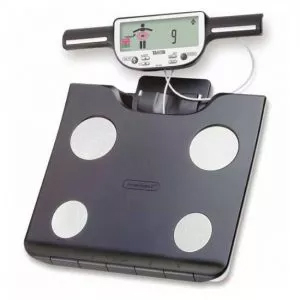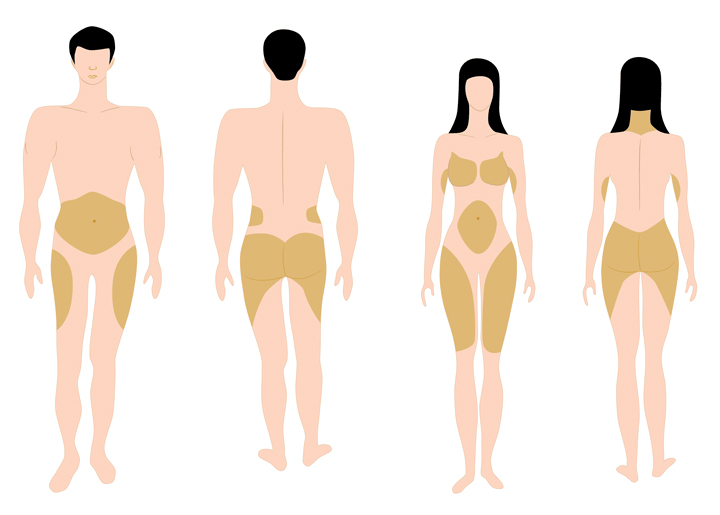Do you want to know your fat percentage? Read the most important information here and calculate your body composition!
Are you curious about your body fat percentage? Read here how to calculate this yourself and see what a healthy fat percentage is!
What is the fat percentage?
The fat percentage indicates the amount of fat stored in your body. This is your total body weight minus the lean mass (muscles, bones, water, tendons, tissues, organs, etc.). The amount of fat in your body consists of two parts:
- Essential fat, which your body needs to function
- Non-essential fat, which is stored as an additional energy source.
What is a healthy fat percentage?
Fat is an organ, just like our heart and lungs. It not only serves as an insulating layer to keep us warm but also has several other functions. It provides us with energy and also produces all kinds of hormones. For example, hormones are involved in curbing our appetite. For example, the satiety hormone leptin.
Too high and too low a fat percentage is unhealthy. Too high a fat percentage increases the risk of cardiovascular disease and diabetes[ 1 This especially applies to people with a BMI of 25 and higher in combination with an inactive lifestyle.
Too low a fat percentage is also unhealthy and leads to poorer sports performance. Extreme examples of this are top athletes with such a low fat percentage that they perform suboptimally, bodybuilders who lose their strength due to an extreme diet, or people with anorexia nervosa, where their mental and physical health is jeopardized. Furthermore, fat is also important for proper hormone functioning and absorption of fat-soluble vitamins. In short, don’t drop too low: there is an unhealthy lower limit.
There is a so-called ‘sweet spot/range’ where your weight is in optimal proportion to your performance and health. Coordinate this with a professional who can advise you on this. We can help you with this with online coaching. The tables below give you an estimate for this.
Table healthy fat percentage man
The percentages below indicate whether your fat percentage is healthy.
| Age | Not recommended | Low | Middle | Healthy upper limit |
| 34 years or younger | Lower than 5% | 6-10% | 10-15% | 15-20% |
| 34- 55 years | Lower than 7% | 7-11% | 11-16% | 18-25% |
| 55 + | Lower than 9% | 9-12% | 12-17% | 18-25% |
Table of healthy fat percentage for women
The percentages below indicate whether your fat percentage is healthy. Do you have any doubts about this? Don’t hesitate to get in touch with a dietician.
| Age | Not recommended | Low | Middle | Healthy upper limit |
| 34 years or younger | Lower than 15% | 16 – 23% | 23 – 28% | 28 – 30% |
| 34 years or older | Lower than 18% | 20 – 27% | 27 – 30% | 30 – 35% |
At what fat percentage will my six-pack become visible?
In men, the entire six-pack becomes visible around 12-10% body fat. In women, the entire six-pack becomes visible around 19-21% body fat. Training your abdominal muscles does not help to make your abdominal muscles more visible. Lowering your fat percentage is essential for this. You can read more about this in this article about abdominal exercises.
How do you measure the fat percentage?
You can calculate your fat percentage in a number of ways. Below, you will find an overview of the two most common methods, namely the skinfold measurement and the bioelectrical impedance analysis. Other options that are more accurate but more expensive are measurements using hydrostatic weighing (water bath), DEXA scan (X-ray), infrared, ultrasound, X-ray, TOBEC, NRM, or plethysmography (air displacement).
Skinfold measurement
A skinfold measurement can be performed in different ways. A skin fold is grabbed and measured with the measuring pliers. The number of skin folds you measure varies from 3 to 12. Your (training) partner can do this, or an expert professional or dietician at the gym. This method is not recommended for overweight people because it is quite painful or difficult to measure a large skin fold. In this case, bioelectrical impedance analysis or a regular BMI measurement is a better choice.
What should you pay attention to during a skinfold measurement?
Choose a skinfold meter with an accurate indication of the number of milliliters. If you really want to be sure that everything is going well, have a measurement done by a professional in a fitness center.
Tips:
- It is important that you grab the fat and skin in the right place and not the underlying muscles. Try to grab the fat mass only with your finger and thumb.
- Try to ask the same person each time for a skinfold measurement. People measure in different places and take different thicknesses. By choosing the same person each time, you’re more likely to spot a difference. If necessary, take photos with a marker marking where exactly you grabbed the skin fold.
- When you use the skinfold caliper yourself, remember or write down where you grabbed the skin.
Bioelectrical Impedance Analysis (BIA)
During the bioelectrical impedance analysis, a small current (usually from the hands and feet) runs through the body. The conduction is measured based on the resistance. Tissue with a lot of water and electrolytes, such as blood and muscle, conduct well. Fat mass, air, or bone, on the other hand, hardly conducts electricity. So, the greater the lean body mass, the greater the conductivity of the body. The BIA measurement can be used to determine the water compartments in the body.

The advantage of this method is that it is easy and cheap. A major disadvantage is its insufficiently validated use in sick and older people. There are probably disturbing factors in these people, such as changes in membrane properties and the degree of hydration and salt consumption, which makes the measurement unreliable. In addition, the method is less accurate than a good skinfold measurement or a water bath, which are described below. In addition, certainly do not rely on the fat percentage measurement of a ‘smart’ scale that you have at home. These are not reliable when it comes to measuring your body fat percentage.
Do you also want a lower fat percentage and a fit body but can’t figure it out yourself? Then take a look at SLIMMER: This is our step-by-step plan for a fit body with a personal training and nutrition plan.
How do you reduce the fat percentage?
Reducing the fat percentage is very simple in theory. You do this by losing weight. In other words, eat less than you need. In practice, this appears to be somewhat more difficult.
The most important factor in losing weight is energy balance. Your body uses energy that you take in through food and drinks or stores the energy. If you take in less energy than you need, you will lose weight. This can be either muscle mass or fat mass and depends, among other things, on the circumstances under which the energy deficit occurs.
Exercise and sports can contribute to burning calories. But should you mainly do strength training or cardio to lose weight? You can read a complete approach and explanation in this article about burning fat.
Fat distribution differs between men and women.

As you can read from the tables mentioned earlier, the standard for a healthy fat percentage for men is different from that for women. This is also reflected in the image above, where fat storage in women is generally different from that of men. In women, fat usually does not accumulate around the abdomen but on the legs, hips, and buttocks. Men, on the other hand, are much more likely to store fat on and around the abdomen.
For women, you add an average of 8-10%. Because women often have more fat around the hips and chest and a relatively lower lean body mass. As a result, the percentage is always slightly higher. This does not mean that it has more negative health effects. The starting point is only slightly higher.
In particular, too much abdominal and visceral fat increases the risk of type 2 diabetes and arteriosclerosis in both men and women. For that reason, it is wise to aim for a healthy weight.
Also, look at your hip/waist ratio.
In addition to the fat percentage, it is wise to also look at the waist circumference and hip circumference and the ratio between them. The outcome of this is a possible indicator of health risks such as type 2 diabetes, insulin resistance, and cardiovascular disease. To determine this, divide the waist circumference by the hip circumference. The calculation is as follows:
Waist circumference in centimeters/hip circumference in centimeters
For women, it is recommended that this number does not exceed 0.80. An upper limit of 0.95 is recommended for men. However, these guidelines are based on research results from Western Europeans and Americans. They are, therefore, not applicable to all origins and body types. Research suggests that different ethnicities may have different fat storage and build. As a result, a correction of the fat percentage or BMI measurement is necessary.
If you are overweight, look at the ratio between your waist circumference and your hip circumference and make sure that your waist circumference decreases in proportion to your hip circumference. The following applies: every centimeter less is a step in the right direction if you are overweight. Check this with yourself and measure it once in a while.
Why you shouldn’t attach too much importance to the fat percentage
Our team sees that more and more people are focusing on fat percentage instead of weight. On the one hand, this is good since your weight does not say everything about the ratio between your muscle mass and your fat mass. Your fat percentage gives a better picture of your health status. Despite this, we advise you not to focus blindly on these figures. We believe that athletes and, especially (young) girls, pay unnecessary attention to it. There are two reasons why we are not a big supporter of (often recording your) body fat percentage and how you act accordingly.
Firstly, it is difficult to measure your body fat percentage properly. This is a difficult measurement where you often see that the outcome differs between measurements at the same time. Our preference is for progress photos, where you take a photo once every two to four weeks with the same light clothing and at the same time. See this for yourself and compare the difference. If necessary, show this to others to get a good impression of your progress.
The second reason is that a low-fat percentage (see table above) is unhealthy and not beneficial for your sports performance. In addition, feeling healthy and fit is just as important or even more important than the enormous focus on a very low-fat percentage.
So try to emphasize a healthy and good feeling instead of paying too much attention to numbers.
What about brown fat?
Finally, I would like to end this article with the topic of brown fat. Perhaps you have noticed that the so-called brown fat is gaining more and more popularity. And that is not without reason because it is best not to have too little brown fat.
Brown fat is a healthy type of fat, and having more brown fat can stimulate fat-burning and weight loss. That is a tentative conclusion that we can draw from recent studies. Unfortunately, research into this topic is still in its infancy, so it remains to be seen to what extent we can use brown fat for weight loss and our overall health.






